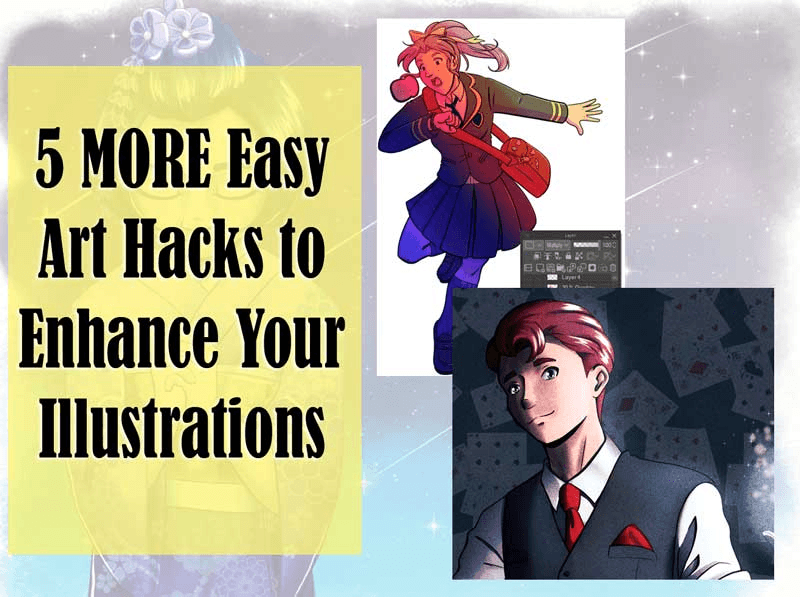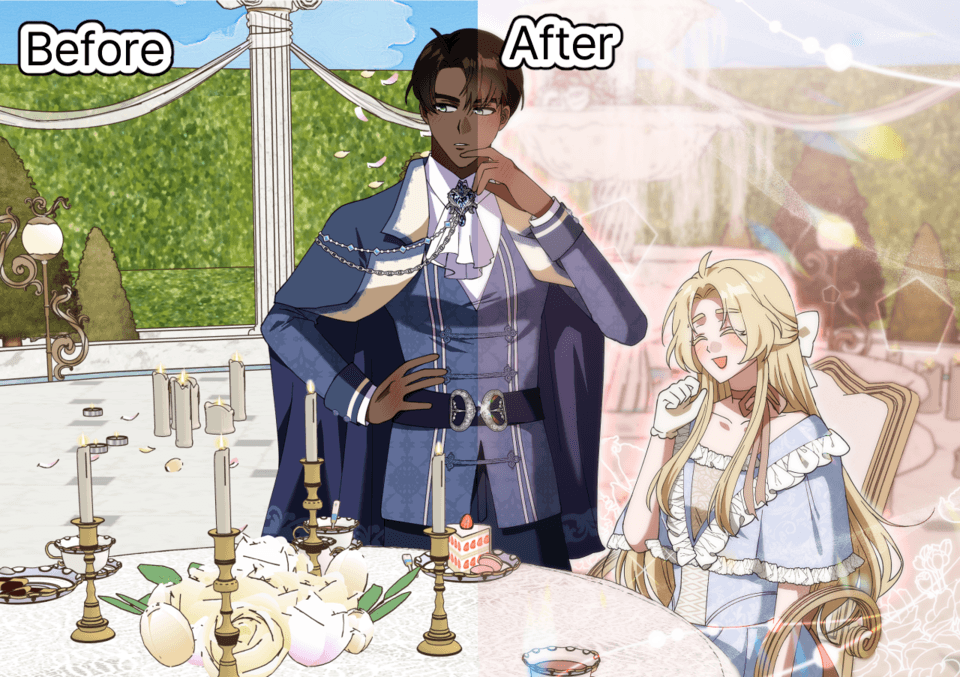Top 5 Functions in Clip Studio Paint for beginners!
Are you new into Clip Studio Paint? I would like so share some useful tools that I really like and that helped me a lot while working.
First of all, we need to know that we can customize our screen with the tools we want to use and position them for easier access.
This is my interface layout:
You can drag and drop elements as you like

You can also add different tools and palettes by clicking the “Windows” menu.
Let’s move to my top 5 useful tools in the program.
1. COLOR HISTORY:
This is my favorite tool. It is very helpful, as it stores all the colors you choose from the color wheel or pick up with the eye dropper tool while you’re drawing. This way you are able to choose the colors you were using before and can keep the same colors without the need to select them again.
How do I use it? When I’m coloring on multiple layers, I add the shadows with the “multiply” layer mode, and usually “lose” the original color I was using, so the color history helps me. There is no need to go to the layer and select the color again, or to keep a color palette hidden on the canvas.
There are some “layer modes” in the program to add lighting or other color effects to a drawing.
2. FILL TOOLS
This tools lets you fill different types of spaces on the canvas with a solid color. We have four different options to choose from by default.
a. The current layer we are working: No matter where you click to fill, it will cover the whole canvas if the layer is empty and not react to any lines drawn on other layers

b. Refer to other layers: In case you have a line art, sketches or any shapes you need to fill an specific space, you can create a layer bellow and this option will fill each space you click on. However, you need to be careful, the blank spaces must be 100% closed; in case the line art is not perfect, you can increase the value for “Close Gap” in the Tool Properties Palette and it will fill the space correctly. You can also drag the bucket tool to fill adjacent areas.


c. Close and fill: This is also very helpful; it is like the lasso selection tool that allows you to fill in a specific area of the drawing. In my case I use it to fill the whole area of the line art to use as a clipping mask after. You just need to be on one layer bellow to the line art.

d. Paint over unfilled areas: Sometimes there are areas that may not be filled using the other options, so this option helps you to complete the fill. It works like a brush to roughly color in the empty spots and they are filled automatically without the need to be super precise

3. EDIT BRUSHES:
This function is not exclusive for Clip Studio Paint, but is very easy to use.
If you don’t feel 100% comfortable with a brush but you still want to use it, you can edit it and turn it into the perfect brush for you. It is very helpful if you don’t want to completely create your own from scratch. You can download more materials and edit each of them whenever you want. Keep testing until you find the correct set up for you.
As you can see, there are many options to explore and change. The best part is that each of them has a description and you already know what are you going to change on that brush. Still, I’m going to show you one by one while editing a pencil we already have.
I chose the “Pencil” sub tool and a brush called “Mechanical Pencil”, which I use for outlines. Then we just click the set up button, the wrench in the corner.
A. Brush Size: This is the most basic one. You need to turn on this option to see it in the brush details and be able to adjust the size when drawing.
I am not going to change the values here.
B. Ink: Here you can edit how the brush is going to work according to the “painting style” you need. You can have a basic brush or a painting one if you choose to edit the opacity or change the degree of color mixing.
I am going to activate the “Color Mixing” option so the brush will create this effect.
C. Anti-Aliasing: It tells you how smooth your brush is going to be on the outside. I prefer the medium for this, so the value stays the same.
D. Brush Shape: This gives you many options for the brush style and the shapes you can apply to it. You must choose a Brush tip, if the Spraying effect is on or off, the Stroke and the Texture. I’m going to choose the following settings for this example.
E. Brush Tip: This will help you modify how the brush flows. Here I just increased the “Brush Density” value.
F. Watercolor Edge: This creats aneffect like a watercolor painting in traditional art around the brush stroke.
G. Correction : When changing this, the brush will be corrected automatically when painting so we wont need the “Stabilization” function. At 0 it is the lowest and it will use no stabilisation at all.
THE RESULT
The result is a more fluent brush that is perfect for painting rather than lineart, which was the case for the pen we started with.
4. CLIPPING MASK
This is one of the most important tools for any software.
It is a layer or set of layers that we apply to a mask above a base layer that defines the shape of the group of layers over it.
How do I use it: The common use for it is to add shadows as the video shows bellow. I apply the clipping mask and use the “multiply” layer mode. The technical definition for that mode is that the program takes the color from the layer below and multiplies it by the color in the layer over it creating the effect of a darker color.

For example: If I need to put shadows, I can use the “multiply” layer mode. If I need to add light, I can use “add”, “add glow” or “overlay” which create brighter colors.
You can change the layer mode in the Layer Property Palette.
If I need to edit the lineart colors I can also use the layer mask functioon. It’s very easy!
1. Create another layer above the lines (I prefer to add a “multiply” layer)
2. Choose the color
3. Paint over the lines.
If we need to combine this layers, we need to do it from the most upper layer about the original layer (you can also press CTRL + E)
5. SELECTION – LASSO TOOL:
This is my favorite tool to use for specific corrections to a sketch or a drawing in general.
Is very easy to use, and you can select using your pen, so the selection is the exact size you need to transform and correct your drawing. You can also add some perspective by transforming an element. And you can transform using the basic “Scale/Rotate” or the advanced ones shown in the “Edit” menu.


I hope you found this helpful!
If you need any extra Information about the tools I use or the way to use them, do not hesitate to contact me! I would be happy to assist you.
Also, you can find my work here: www.stephinni.com
Or my social media:
Facebook: Facebook.com/stephinni
Instagram: Instagram.com/stephinni
Twitter: twitter.com/stephinni
























Comment